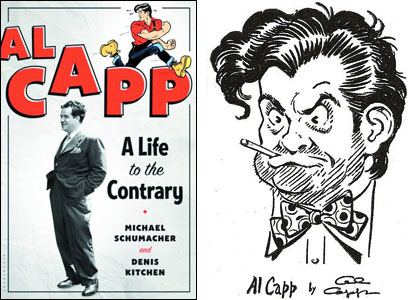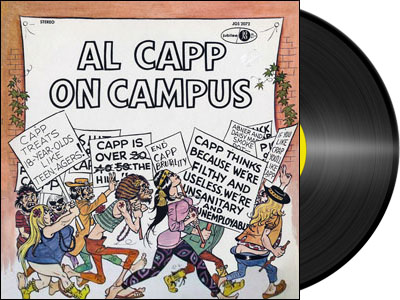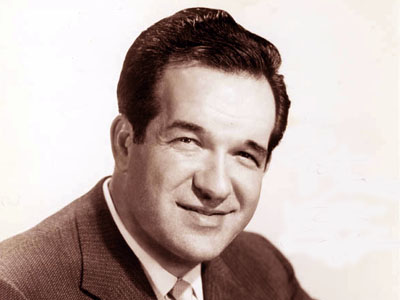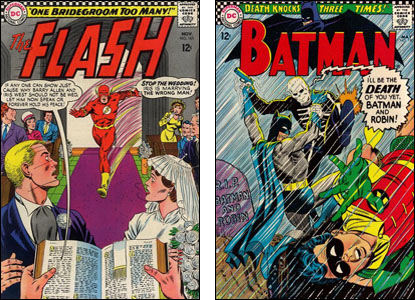It's Stooge Sunday! What better time to follow Moe, Larry and Curley (sic) as they go Back to the Woods? This one hit theaters on May 14, 1937 and it was their 23rd short…
Monthly Archives: April 2013
Go Read It!
Robert J. Elisberg ("Bob" to some of us) about perceptions of failure in Hollywood. Sometimes, a movie that isn't #1 at the box office is treated like the loser of the Heavyweight title fight. He just got paid millions of dollars but he's a "loser" because while he can probably beat up more than 99% of the people in the world, he couldn't beat one guy. You can do quite well in show business not being the absolute top grosser.
Recommended Reading
Daniel Larison has a good (I think) take on the problem the Republican party will have on the odd chance that it ever wants to win the presidency again: Most voters don't want another George W. Bush or even someone who thinks Bush was a good president whose policies should be reinstated wherever they no longer apply. But the leaders of the G.O.P. don't want to admit that Bush was a failed president.
Recommended Reading
As Doyle McManus points out, a lot of conservative Republican economists favor the idea of a carbon tax, especially if it's revenue-neutral, lowering other kinds of taxes. As he also points out, the main opposition to this comes from Republican politicians.
The Shame of Dogpatch

If you'd like to believe all great artists are great human beings, you might want to lay off Al Capp: A Life to the Contrary, a new book by Michael Schumacher and Denis Kitchen. It's an exhaustive and apparently well-researched biography of the creator of Li'l Abner, done with access to Capp's personal papers and many of his family members and close associates. I know Denis as a man who has done more than anyone else to honor and promote the genius body of work (well, genius up to a point) that was Abner…so I applaud his honesty. It must be tough to co-author a book that reveals that the creator of one of your favorite comic strips was a pretty horrible human being. I guess that point is unavoidable when you write about a serial rapist.
Abner was a wonderful comic strip, at least until the sixties when it evolved into what a friend of mine used to call "the kind of conservatism that embarrassed Barry Goldwater." Milton Caniff, a longtime friend of Capp's, was as far to the right in his work but somehow never turned into a clown about it. For Capp, the political stuff seemed to be all about saying outrageous things to get on TV and get attention. Thank goodness there's no one doing that kind of thing today.
I could easily overlook his politics but I have a bit more trouble with the way he used his power and position to force himself on unwilling young women. A year or three after Capp plea-bargained his way out of legal jeopardy and swore to keep the hell away from co-eds, I met a lady who had been one of his victims and heard her tell a story that was…well, the kind of thing that almost makes you ashamed to share the perpetrator's gender. The book also does not speak well of Capp in other, non-sexual capacities. All of this has impaired my ability to love his work. I certainly understand the argument that it shouldn't but it does.
I met Al Capp but once. Not long before the revelations, back when he was lecturing on college campuses, he appeared in the quad area at U.C.L.A. This was around late 1970 and that was my then-current place of education. Little clip-out forms had been printed in the school paper, The Daily Bruin. They said at the top, "Al Capp is an expert on nothing and has opinions on everything. I would like to ask Al Capp the following question…" and then there were blank lines on which you could write a question and deposit it in a box at the Bruin office. This was how Capp did his "lectures," responding to questions submitted this way. I submitted one asking him about his feelings on the Broadway play and subsequent movie, then arranged with friends to go see 'n' hear him.
The night before, I listened to Al Capp on Campus, a recently-released record that captured one of his earlier speaking engagements. Then on the big afternoon, we sat and experienced it live. Capp limped up to the podium amidst a mix of applause and boos. The boos clearly were like the way when you go see Peter Pan, you're expected to boo Captain Hook on his entrance. Capp was there, after all, to tell us that as college students, we were all worthless scum.

The first part of his presentation, as I remember, was a too-long account of why he was lecturing there for much less than his usual speaking fee. He'd been insulted by the money U.C.L.A.'s speakers bureau had offered but then learned that a young and talented artist he knew was up for a scholarship at our university. So, he explained, he'd agreed to appear for bad money if it would go towards that student's education. Throughout his talk when he insulted us and we booed back, he'd occasionally remind us he was only doing this to help a student and I think once he threatened to walk off and keep the money for himself if we got unruly.
A lady I knew had been involved in setting up Capp's appearance and later that day, she told me the story about lowering his price to help a student was at least in part untrue. She said Capp spoke for whatever price he could get — often, less that he was getting for being there today — and they couldn't verify he ever received this much higher amount he claimed as the norm. They also couldn't verify how much of today's fee, if any, was going to a student Capp did not identify. The one thing she was sure of was that she could get me into a reception that evening where I might have the chance to meet Mr. Capp…but I'm getting ahead of myself here.
After he finished talking about his pay, he hauled out a pile of (allegedly) the questions we'd submitted. He said he'd just been handed them and had not seen them before, then he began to read them aloud and offer (mostly) witty or at least funny replies. My question was not among them…and neither were any others that had been submitted via the Daily Bruin; not unless we'd all submitted the same ones, verbatim, as the kids in the audience for that Al Capp on Campus record. The questions and his replies were word-for-word identical. They were even in the same order. At one point, I whispered to my friends what the next question and answer would be…and sure enough, I was right. Near the end, Capp did take some live questions from the floor, mostly so he could insult the questioners to their faces.
His thesis, to the extent he had one, went something like this: He had lost a leg when he was a kid. He had had no family connections or wealth but in spite of all that, he had become rich and famous…and in America, anyone could do that. If you couldn't, you were a lazy bum who didn't deserve it. At one point, he said, "And I am proof," and someone yelled out, "And you are white!" That makes some difference now — we can debate how much — but it made more back in '70 and a lot more back in the thirties when Al Capp (né Caplin) was growing up. His closing speech though was rather nice and warm and reminded me a bit of those cop-out endings Don Rickles used to do where he toasted the audience for being good sports. I got the feeling Capp did it so he'd exit to applause…and make it off the quad alive.
That evening, my friend did indeed get me into the reception. Capp was good-natured but loud and actually rather funny, though everything he uttered sounded like a prepared line. Years later, his brother Elliott told me Al had notebooks full of scripted quips for any situation he was likely find himself in. He'd study them before any public or social engagement and apply them as necessary. When I was introduced to him as someone involved (or maybe just interested) in the field of cartooning, he dug into his repertoire of pre-existing remarks about comics, laid a few on me and then asked if I wanted to know anything about Li'l Abner. I said, "I do but I'd rather ask you about Long Sam."
That was another strip Capp had done for a time, working with an artist named Bob Lubbers, and I was probably the only person within a hundred-mile radius who'd ever heard of it. Upon its mention, he turned into a completely different person and for the next ten minutes or so, he didn't talk to me like Al Capp the Public Figure. He talked to me like Al Capp, the guy who was proud to be a cartoonist. We talked about Milton Caniff and Charles Schulz and others in that profession of his and he seemed genuinely pleased that I knew his work on that level. Then a reporter stepped up and interrupted and he turned back into The Public Figure again, carrying on about "those kids today." I was thereafter ignored.
Still, I left there with a certain respect for the guy. It was all an act but it wasn't a bad act. At the time — I know some readers of this blog will find this hard to believe — I was rather conservative. I didn't like most of the current conservative leaders but I liked what they were supposed to stand for. Not long after, I began to drift to the left. It was not because of my in-person experience with Al Capp…but realizing what a phony he was sure caused me to reassess a lot of what he and prominent right-wingers of the day were selling. His attitude towards the poor, the one he cribbed from Marie Antoinette, particularly repulsed me.

Shortly after the day Capp did his well-scripted spontaneous routine at U.C.L.A., I was talking with my friend Shel Dorf, who is of course best remembered as the most visible founder of what we now call Comic-Con International. Shel worshipped all cartoonists — if you were syndicated, you were at least a small-"g" god — and had an amazing collection of strips clipped from newspapers. When we spoke of Capp, he asked if I'd ever read a long run of the early Li'l Abner strips. I hadn't. In '70, there were no reprint collections or anyplace one could find such a thing. Then a week later, Shel dropped off several thick scrapbooks at my home — a loan, of course. They contained about three years of late 1940's Abner and boy, was that stuff good. I'm a big fan of great newspaper strips but not when read one-a-day as they appear. Gimme a couple of months of them at a time or forget it.
So even as I became a lesser fan of Al Capp as a human being, I became a bigger fan of his work. For a while, I could balance the two…but then came the news stories of Capp being ordered off college campuses and then he pled guilty…and when Shel offered me more volumes of his scrapbooks, I asked if he could loan me Walt Kelly or Elzie Segar instead.
I should mention something that fascinated me. In the seventies, I had occasion to meet and hang out with a lot of Capp's peers — men (they were all men) who produced other syndicated strips and were roughly of the same generation. Their profession then had a certain camaraderie and there was a "mens' club" feel to the National Cartoonists Society.
The name of Capp came up often and everyone had stories. I witnessed an amazing evolution…perhaps you could call it an enlightening. At first, tales of Capp's sexual advances were treated almost as colorful pranks. It was not denied that he did such things but what he was said to have done was also not viewed as rape or even a crime. He was like some guy who was out on a date with a girl and had tricked her into going farther than she wanted. One prominent cartoonist shocked me — and I am not easily shocked — with the expressed belief that "these girls today, going around dressing like that…they're practically begging for it."
But you could feel that change with all but the most neanderthal of my sex. At first, the allegations against Capp, even the ones he'd copped to, were "trumped-up" charges by political enemies who would stop at nothing to silence him. That rationale eventually lost all its steam as did the notion that rape is some form of zany mischief. In the seventies, a lot of males finally woke up about such matters and adjusted accordingly. At the 1983 N.C.S. banquet, I even heard the "practically begging for it" cartoonist describe Capp, who'd died a few years prior, as "a brilliant cartoonist but a very sick man who should have been locked up."
That was a few years after I met that lady — the one I mentioned earlier who claimed to me that she'd been assaulted by Capp. I couldn't imagine any reason she would have had to make up such a thing, especially since she'd have had to research his modus operandi. What she told me — trembling with rage — roughly matched other encounters that had been reported. Needless to say, a story like that has a special impact when you hear it straight from a victim, still putting out angry tears long after the incident. It was years later that I could even stand to read Li'l Abner…around 1988, I suppose, which was when Denis Kitchen — co-author of the book I set about to review here — began reprinting the early ones.
Yes, I guess I started this blog post as a favorable review of Al Capp: A Life to the Contrary and then made a right turn and wrote instead about my own dual feelings about the man. "A brilliant cartoonist but a very sick man who should have been locked up" is not a bad description…but read this honest, important book and decide for yourself. You can order a copy via this link. Maybe you'll even find a way to separate the artist from his art. I sure can't.
Today's Video Link
Another Allan Sherman song you probably never heard…
Yesterday's Tweeting
Bird is the Word
A number of folks have written me with their suspicion that Poncho the Singing Parrot, seen in today's video link with Johnny Carson, is a fraud. They suspect the guy holding him is a ventriloquist. I actually met Poncho and his handler when we had them on That's Incredible! and if it was a trick, it sure fooled me…and I know a little about ventriloquism. So, come to think of it, did Johnny Carson who actually was one early in his career. I don't think he'd have gone along with a hoax.
Yes, the gent holding Poncho does have a frozen ventriloquist grin on his face when Poncho is singing but Poncho does make noises while the human talks…and the sound seems consistent with the sound Poncho makes when allegedly singing. There's also the matter of Poncho's beak not being notably out of step with the lyrics. If he's lip-syncing — make that beak-syncing — he's better than Britney Spears.
Also, there's this. If you go to YouTube and search for "poncho singing parrot," you'll find a number of videos of performances over the years. It's the same act and the same songs and almost certainly the same bird…but I count at least four other handlers holding him. One man could conceivably learn how to do that voice without moving his lips…but four? I don't think so. Let's not go Alex Jones on this…
Finding Murphy

I mentioned that Murphy Anderson drew the cover of Flash #165. I also said that Carmine Infantino may have done a rough sketch for the cover but if it had been signed, it wouldn't have been signed by him.
Well, as a number of folks have pointed out to me, that cover was signed…by Murphy Anderson. Here's a link to a large image of it. See if you can find where he signed it.
Today's Video Link
Let's take a break from the news out of Boston and watch Johnny with a Singing Bird…
More Monday Morning
One suspect dead. Other suspect at large. Internet orgasmic at flow of info about them…so much there that can be twisted to advance one's political causes. I can't wait to hear how this all proves we need to cut taxes on the rich.
A Bit Later…
Okay…so now they're saying Suspect #1 from the Marathon Bombings is dead and #2 is on the loose in Watertown. No more pretense that all this might not be connected to the bombings. See what some of you miss by going to bed early?
Very Early Friday Morn
I'm watching news coverage of what's going on tonight in Watertown, Massachusetts and on the M.I.T. campus nearby. Everyone's trying to say "They caught the Marathon Bombers" while still being able to say "We never said that" in case it turns out to be a series of unrelated crimes. They were especially cautious over on CNN and I wonder how much of that is because it's the middle of the night so the story isn't being covered by Wolf Blitzer, Anderson Cooper and other superstar reporters. The middle of the night is also not as competitive and I suppose there's less urgency to be first.
And now I'm watching NBC which has gone live with the story, preempting Leno and Fallon reruns. They have measured, cautious coverage but since only so much is known, they're saying the same things over and over and —
Whoops! I blinked and now I'm watching Jimmy Fallon interviewing Tracy Morgan…so it's back to CNN. They're waiting for a press conference. So am I.
Yesterday's Tweeting
- Can't wait to find out the religion of the Boston bombers so we'll know which group of bigots gets to exploit the tragedy. 15:48:12
Carmine Corrections

There have been a number of wonderful things written about Carmine Infantino since his sad passing. There have also been a few in need of some straightening-out…
- Carmine did not create or even co-create Adam Strange. That character first appeared in Showcase #17-19 and Infantino had nothing to do with those issues, the interiors of which were drawn by Mike Sekowsky with inkers Bernard Sachs and Joe Giella. The covers were penciled by Gil Kane but reportedly, the visual image of the hero was designed by Murphy Anderson when he drew a cover for Showcase #17 which was not used. Infantino took over the artwork when Adam Strange was teleported into DC's Mystery in Space comic as of #53. Carmine became the artist most closely identified with the feature but he was not in on its creation.
- Many folks are repeating Wikipedia which says at the moment that "In late 1966/early 1967, Infantino was tasked by Irwin Donenfeld with designing covers for the entire DC line. Stan Lee learned this and approached Infantino with a $22,000 offer to move to Marvel. Publisher Jack Liebowitz confirmed that DC could not match the offer, but could promote Infantino to the position of art director." For what it's worth, I don't believe that offer, which was about as much as Jack Kirby was getting at the time. That was largely a measure of how many pages he produced and I don't believe Infantino could have matched Kirby's output. He hadn't in his work for DC. Moreover, Stan had tried a number of seasoned pencilers who had not been able to give him the kind of work he wanted for the current Marvel line, some "bombing out" as of their first attempt. Infantino hadn't drawn one page yet for that line. Can we really imagine Marvel — then, a notoriously frugal outfit — giving someone a contract the equal of Kirby's when that someone had yet to prove he could work the way Stan insisted his artists work? I sure can't, though I can theorize Infantino told DC he had such an offer to pressure them into countering.
- Some obits say that it was Irwin Donenfeld who promoted Infantino to editorial director and the date is given variously as 1966, 1967 and 1968. It was the middle of 1967 and it was not at the choice of Donenfeld. Donenfeld had been editorial director. He was fired. Liebowitz, who was then ascending to the Board of Directors of the corporation that was then acquiring DC Comics, recommended Infantino for the position. Infantino was promoted to publisher in 1971. Also, Infantino did not bring in Dick Giordano as a DC editor. Donenfeld brought Dick Giordano in as a DC editor. Infantino got rid of Dick Giordano as a DC editor. The two men never did get along very well and one of the things Carmine was angry about after he was let go as publisher was that Giordano was later brought in to fill a job roughly equivalent to his old Editorial Director position.
Lastly: You see the cover to Flash #165 up atop this item? People keep reprinting that as an example of Infantino's superb work as a cover artist on that comic…and I think it's the only cover from the period when he was drawing the comic that he didn't draw. It was penciled and inked by Murphy Anderson. And you see the cover to Batman #180 right next to it? Infantino didn't draw that, either. That's Gil Kane and Murphy Anderson. Carmine may have done rough sketches for one or both of these covers but if they'd been signed, they wouldn't have been signed by him.